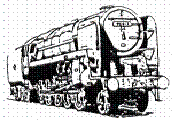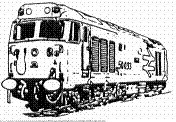Way back in 1896 gold was
discovered at Bonanza Creek in the Klondike area of the Yukon, Canada
by one George Cormack and his two Indian companions – Skookum
Jim and Dawson Charlie! Although their findings were very small indeed,
the breaking news was to instigate a fever amongst the population to
become rich and by 1897 the Klondike Gold Rush had begun.
In the following year over 60,000 would be prospectors
made their way to the Klondike in search of a fortune, some taking the
shorter but steeper Chilkoot trail route from Dyea near Skagway, climbing
what was known as the "Golden Stairs" cut into the snow and
which took them to the summit of the pass. It was a condition that each
man had to take with him over a thousand pounds of supplies which he
did on his back. The flow was continuous and the men looked like a line
of ants in the snow all the way to he summit.
Others took the White Pass trail, longer but less steep,
allowing pack animals to carry their supplies to Lake Lindeman where
it was necessary to construct a boat of some sort to transport them
down the Yukon River and to the gold fields. Both trails were hazardous
with as many as 3,000 horses losing their lives in the treacherous conditions
on the White Pass route and many men dying in avalanches on the Chilkoot
trail. Even those men that finally completed their 550 mile trek to
Dawson City were often too tired and exhausted to work a claim.
By 1898 it was obvious that a mode of transportation
from Skagway to the north was urgently required. After a chance meeting
in a Skagway Hotel of Michael J Heney, an experienced railroad contractor
looking for work, and representatives of a London Investment bank, the
Whitepass and Yukon Railroad Company was formed after a great deal of
discussion. In May of that year, construction of the 3 foot gauge railway
commenced.
It took 15 months to complete the 41 miles from Skagway
to Bennett and a further 12 months for the remaining 69 miles to Whitehorse.
A total workforce of 35,000 men were working at varying stages of the
constructions, with 2,000 labourers working on a section at any one
time.
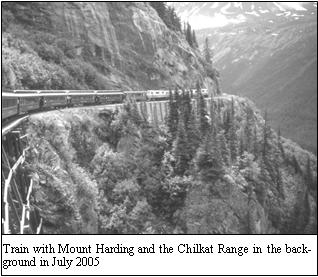
Starting at sea level in Skagway, United States, close
to the docking area, the line heads inland, passing the railroad maintenance
shops on the left, then it rises gently to 402 feet, crossing the East
fork of the Skagway River on a slow hairpin curve. Continuing to climb
through Black Cross Rock, just 10 ½ miles from Skagway where
two railroad workers were involved in a blasting accident. They were
buried under a 100 ton granite rock on 3 August 1898.
The steep mountain sides were the main obstacle in
the construction of the railway and over 400 tons of explosives were
used to get to the summit. Bearing this in mind, less than 35 fatalities
were recorded over the complete construction period.
At Heney Station, named after the main contractor of
the line, the route turns east to Glacier Station which was once a watering
stop for the thirsty steam engines and section crews lived here to maintain
the track bed.
Crossing the Skagway River for the last time and continuing
to climb along a shelf cut into the mountain side and turning north
again for two miles at around a 3% grade to Tunnel Mountain, the line
crosses a timber trestle bridge over a chasm above Glacier Gorge. The
gorge is 1,000 below and the line enters straight into the tunnel through
the mountain at 2,275 feet. Construction of this tunnel took place in
the height of winter, with heavy snow and at times temperatures plummeting
to 60 degrees below!
|
|
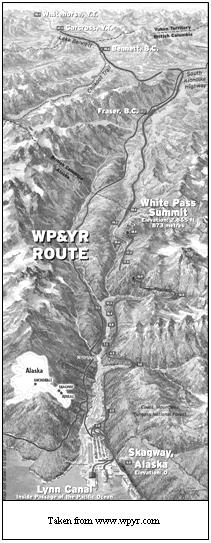 Emerging
from the tunnel the line shortly passes Dead Horse Gulch, the spot
on the old White Pass trail where many pack horses met their end from
neglect and overloading. Emerging
from the tunnel the line shortly passes Dead Horse Gulch, the spot
on the old White Pass trail where many pack horses met their end from
neglect and overloading.
Just after this the old original track bed swings left onto a steel
cantilever bridge which at the time of building was the tallest of
its type in the world, and was used until 1969. From that time the
route by-passed the bridge and now passes over a small trestle into
a 675 foot long tunnel through the mountain to White Pass summit,
almost 20 miles from Skagway and an elevation of 2,865 feet, which
now brings the line into British Columbia, Canada.
From here there is a gentle grade down through the lake areas to
Fraser and on to Bennett, then over the border again, into the Yukon
and on to Whitehorse, the original destination, 110 miles from Skagway.
The last spike was driven at Carcross with the meeting up of construction
crews from Whitehorse in the north and Bennett in the south, on 29
July 1900.
The railway was profitable, carrying gold and supplies
then ore and concentrates to the docks at Skagway. During World War
II supplies were carried for the US Army’s construction of the
Alaskan Highway. This resulted in the railway being expanded to include
new stock to cope with the demand.
However, with the closure of the mines, and plummeting
metal prices, in 1988 the operations of the line were suspended, only
to be re-invented as a tourist attraction in 1988.
The motive power today consists of diesel electric GEC units from the
1950s and ALCO units from the 1960s together totalling 20 in the fleet.
There are only two steam locos, a fully restored 1947 Baldwin 2-8-2
Mikado No. 73 and in restoration, a 1907 Baldwin 2-8-2 No. 60 built
for the WP & YR which last ran in 1954. There is also an 1898 steam
rotary snow plough built by the Cooke Locomotive and Machinery Company
of Paterson, New Jersey, used up to 1965 to tackle up to 12 feet accumulations
of snow on the route in severe winters. Today the trains run the 28 miles to Fraser, a most
spectacular journey with breathtaking views and an opportunity
to observe the enormous obstacles overcome by the construction
crews back in the gold rush days. It is indeed a monument to their
strength and determination to succeed in a hazardous terrain and
very harsh climate.
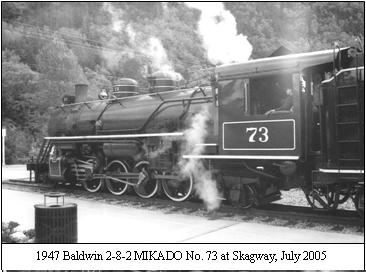
All photos: Brian Higgins
|
